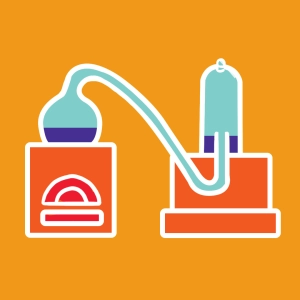 Lavoisier’s experiment
Lavoisier’s experiment
The animation above describes one of the founding experiments of modern chemistry. We deliberately illustrated this experiment with period sets and instruments, as Lavoisier described them. It should be noted that it is mainly his wife Marie-Anne Pierrette Paulze whose biography we invite you to discover, and who is the origin of many articles and illustrations (and probably much more) on behalf of her husband Antoine-Laurent de Lavoisier (1743-1794). Also of historical note here is how Berthe Bussard and Hélène Dubois describe this experiment in the manual "Leçons élémentaires de chimie" (Basic Chemistry Lessons) published by Belin in 1897:
“Lavoisier showed in 1774 that air is a mixture of oxygen and another gas, nitrogen. For twelve days and twelve consecutive nights he heated mercury in a retort flask whose curved neck ended at the top of a bell jar turned over a mercury tank. He sucked some of the air from the bell jar, using a curved tube, so that the mercury level was higher in the bell jar than in the tank. This arrangement made it easy to track changes in the level of mercury in the bell jar, and at the same time ensured the stability of the bell.
“On the second day, Lavoisier saw the surface of the mercury covered with reddish patches that increased for five days, and the level rose in the bell. He continued to heat until the twelfth day; no more changes occurred in the unit, so he let it cool down. The gas remaining in the flask and the bell jar extinguished a lit candle; this gas was not breathable: small animals immersed in this gas died there. He gave it the name in Greek azote (“a” without, “zoos” life). He put the red compound in a very small retort to leave as little air as possible. When it was heated, he collected oxygen from the mercury tank, and found mercury in the retort; the red compound was therefore a combination of mercury and oxygen, that is, mercury oxide. Lavoisier passed through the same bell the remaining nitrogen of the first experiment and the oxygen collected in the second; in so doing he obtained a mixture that had all the properties of atmospheric air. He had thus established by analysis and synthesis that the air is a mixture of oxygen and nitrogen. Since Lavoisier, other experiments have been carried out that have determined very accurately the composition of the air and proved that nitrogen accounts for four-fifths and oxygen for a fifth.
All these experiments are based on the same principle: remove oxygen from the air and leave nitrogen."
